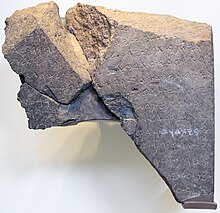
Back Tel Dan-stele Afrikaans نقش تل القاضي Arabic Cercu de Tel Dan AST Estela de Tel Dan Catalan Stéla z Tel Danu Czech Tel-Dan-Inschrift German Steleo de Tel Dan Esperanto Estela de Tel Dan Spanish سنگیادبود تل دان Persian Tel Danin piirtokirjoitus Finnish
| Tel Dan Stele | |
|---|---|
 | |
| Material | Basalt |
| Writing | Old Aramaic (Phoenician alphabet) |
| Created | 870–750 BCE |
| Discovered | 1993–94 |
| Present location | Armstrong Auditorium (Edmond, Oklahoma) |
The Tel Dan Stele is a fragmentary stele containing an Aramaic inscription which dates to the 9th century BCE. It is the earliest known extra-biblical archaeological reference to the house of David.[1][2] The stele was discovered in 1993 in Tel-Dan by Gila Cook, a member of an archaeological team led by Avraham Biran. Its pieces were used to construct an ancient stone wall that survived into modern times.[2] The stele contains several lines of ancient Hebrew. The surviving inscription details that an individual killed Jehoram, King of Israel-Samaria, the son of Ahab, and Ahaziah of Judah, a king of the house of David.[1] The stele, which is ordinarily on display at the Israel Museum,[3] is currently (from September 2024 to November 22, 2024) on exhibition in the United States at Armstrong Auditorium in Edmond, Oklahoma.[4] It is known as KAI 310.
These writings corroborate passages from the Hebrew Bible, as the Second Book of Kings mentions that Jehoram is the son of an Israelite king, Ahab, by his Phoenician wife Jezebel. The likely candidate for having erected the stele, according to the Hebrew Bible, is Hazael, king of Aram-Damascus, whose language would have been Old Aramaic. He is mentioned in 2 Kings 12:17–18 as having conquered Israel-Samaria but not Jerusalem:
At that time, King Hazael of Aram came up and attacked Gath and captured it; and Hazael proceeded to march on Jerusalem. Thereupon King Joash of Judah took all the objects that had been consecrated by his predecessors, Kings Jehoshaphat, Jehoram, and Ahaziah of Judah, and by himself, and all the gold that there was in the treasuries of the Temple of GOD and in the royal palace, and he sent them to King Hazael of Aram, who then turned back from his march on Jerusalem.[5]
- ^ a b Hovee, Eric (14 January 2009). "Tel Dan Stele". Center for Online Judaic Studies. Retrieved 23 September 2019.
- ^ a b "Stone Tablet Offers 1st Physical Evidence of Biblical King David : Archeology: Researchers say 13 lines of Aramaic script confirm the battle for Tel Dan recounted in the Bible, marking a victory by Asa of the House of David". Los Angeles Times. 14 August 1993. Retrieved 23 September 2019.
- ^ "Samuel and Saidye Bronfman Archaeology Wing". The Israel Museum, Jerusalem. Archived from the original on 12 August 2011. Retrieved 26 August 2011.
- ^ Flurry, Gerald. "King David Comes to America". Armstrong Institute. Retrieved 21 September 2024.
- ^ "II Kings 12:18-19". www.sefaria.org.